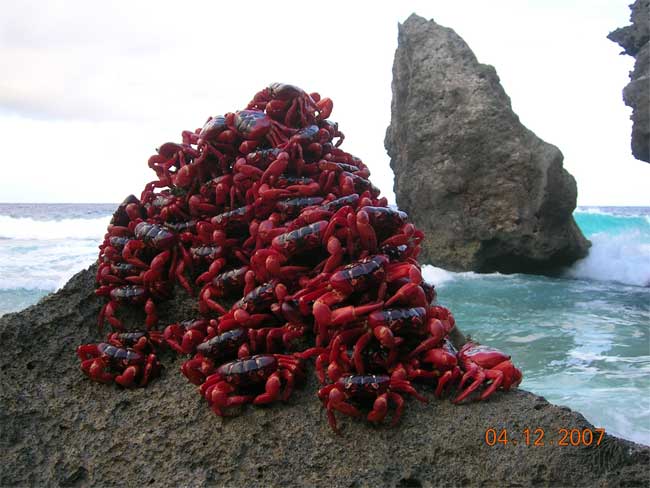Secret to Red Crabs' Epic Migration Discovered

This fall millions of crabs will undertake an arduous, miles-long migration to the Indian Ocean where they reproduce. Now scientists have figured out the key to the athletic feat: crabby hormones.
When monsoon rains set in on Christmas Island, south of Indonesia, the teensy crabs, just 8 inches (20 centimeters) long, go from a leisurely existence of hanging out in their burrows on the floor of the rain forest, to scuttling along for miles toward the coast. [Top 10 Most Incredible Animal Journeys]
"Their migration is extremely energetically demanding, since the crabs must walk several kilometers over a few days," said researcher Simon Webster, an endocrinologist at Bangor University in North Wales, U.K.
Scientists had long puzzled over what changes in the crabs' bodies took place to enable this stark change in behavior.
Webster and Steve Morris from the University of Bristol in England looked at the so-called crustacean hyperglycemic hormone (CHH), which, among other things, controls the conversion of stored energy in the muscles (called glycogen) into usable fuel (called glucose). It's the equivalent of a marathoner consuming a sugary gel to keep their muscles going.
The researchers expected that during the epic migration, which Webster said is the equivalent of humans running successive marathons, the crabs would have high CHH since their bodies would need tons of fuel.
However, the red crabs (Gecarcoidea natalis) showed higher levels during the dry season, when they are relatively inactive.
Sign up for the Live Science daily newsletter now
Get the world’s most fascinating discoveries delivered straight to your inbox.
To figure out the paradox, they exercised crabs in the field during the wet and dry seasons, finding CHH increased for both scenarios. Perhaps the reason they didn't see this hormone signal in the field earlier was because the red crabs had been munching on snacks along the way so they didn't need to use their stored energy. To find out, the team injected the crabs with glucose during the exercise stints, finding during the wet season there was no such spike in CHH, suggesting the glucose turned off the release of stored energy from the crabs' muscles.
Essentially, the crabs don't want to use up all of their onboard "gel packs." So if there's a little bit of glucose available, their bodies' save the glycogen for later. The result ensures they can complete the 3-mile (5-kilometer) journey.
The research, funded by a Natural Environment Research Council (NERC) grant, is published in the September issue of the Journal of Experimental Biology.
- Animal Senses Humans Don't Have
- 10 Amazing Things You Didn't Know About Animals
- 10 Species You Can Kiss Goodbye
Jeanna Bryner is managing editor of Scientific American. Previously she was editor in chief of Live Science and, prior to that, an editor at Scholastic's Science World magazine. Bryner has an English degree from Salisbury University, a master's degree in biogeochemistry and environmental sciences from the University of Maryland and a graduate science journalism degree from New York University. She has worked as a biologist in Florida, where she monitored wetlands and did field surveys for endangered species, including the gorgeous Florida Scrub Jay. She also received an ocean sciences journalism fellowship from the Woods Hole Oceanographic Institution. She is a firm believer that science is for everyone and that just about everything can be viewed through the lens of science.









